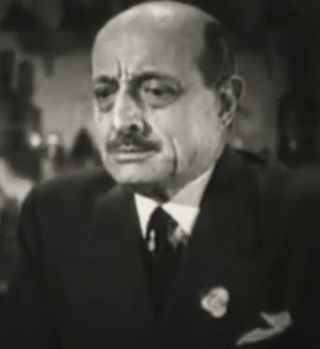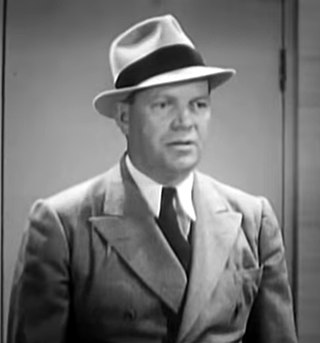Related Research Articles

Jimmy Aubrey was an English actor who worked with both Charlie Chaplin and Laurel and Hardy, having gone with Fred Karno's theatrical company to America in 1908. However he left to start on his own in vaudeville. He started in comedies, then went on to comedic roles in drama.

Roy Del Ruth was an American filmmaker.

Eugene Borden was a French-American actor, active in Hollywood from the silent era until the mid-1960’s. Born in Paris, he immigrated to the United States as a teenager, and entered the film industry a short time later. He appeared in over 150 films, as well as shorts, serials, and television shows.

André Cheron was a French-born American character actor of the late silent and early sound film eras. During his 16-year career he appeared in over 100 films, usually in smaller roles, although with the occasional featured part.
Ben Markson was an American screenwriter active from the very beginning of the sound film era through the end of the 1950s. During his 30-year career he was responsible for the story and/or screenplay of 45 films, as well as writing the scripts for several episodic television shows in the 1950s.

LeRoy Stone was an American film editor and a screenwriter.

John Sheehan was an American actor and vaudeville performer. After acting onstage and in vaudeville for several years, Sheehan began making films in 1914, starring in a number of short films. From 1914 to 1916, he appeared in over 60 films, the vast majority of them film shorts.

Francis Sayles was an American character actor at the beginning of the sound film era. In the short dozen years of his career he appeared in over 100 films, most of them features. While he was normally cast in small uncredited parts, he was occasionally cast in featured roles, as in the role of Dickman in the 1934 film, One in a Million, starring Dorothy Wilson and Charles Starrett.

John Hugh Elliott was an American actor who appeared on Broadway and in over 300 films during his career. He worked sporadically during the silent film era, but with the advent of sound his career took off, where he worked constantly for 25 years, finding a particular niche in "B" westerns.

John Melvin Bleifer was an American actor whose career began at the end of the silent film era, and lasted through the mid-1980s. He appeared in feature films and film serials, and in a number of television series and miniseries. Bleifer also acted on stage, and appeared in several Broadway productions.

Cliff Reid, also known as George Clifford Reid, was an American film producer and film production studio founder during the 1930s and 1940s. In addition he also directed film shorts, and was the assistant director on several feature films.

James Bush was an American actor from the 1930s until the early 1950s. He appeared in more than 100 television shows and films, more than 80 of them being feature films.

Edward Arthur Killy was an American director, assistant director and production manager in films and television. He was one of the few individuals to be nominated for the short-lived Academy Award for Best Assistant Director. During his 30-year career he worked on over 75 films and television shows.
Arthur T. Horman was an American screenwriter whose career spanned from the 1930s to the end of the 1950s. During that time he wrote the stories or screenplays for over 60 films, as well as writing several pieces for television during the 1950s.

John F. Kelly was an American actor whose career spanned the very end of the silent film era through the 1940s. While most of his parts were smaller, often-uncredited roles, he was occasionally given a more substantial supporting or even featured role.
Arthur Martinelli was an American cinematographer whose career spanned from the silent era through the golden age of American movies. During that time he shot over 100 films. A pioneer in the industry, he was the cinematographer to film the first movie to star Ethel and John Barrymore.

Dixon Howard "Dick" Hogan was an American actor of the 1930s and 1940s. During his 12-year career he appeared in over three dozen films, in roles which varied from unnamed bellhops to featured and starring roles. His final film performance was as the murder victim in Alfred Hitchcock's Rope (1948).

Frank Redman was an American cinematographer from the end of the silent era through the 1960s. During his almost 40-year career, he shot over 60 feature films, as well as several film shorts and serials. In the 1950s, he transitioned to the smaller screen, where he was most well known for his work on the iconic television show, Perry Mason from the end of the 1950s through 1965.
George Crone (1894–1966), also known as George J. Crone, was an American director and editor, whose career spanned both the silent and sound film eras. He began his career cutting the silent film Let's Be Fashionable in 1920. Between that film and his final screen credit, editing Arruza, he edited over 40 films, and directed over a dozen more. Arruza was released 6 years after Crone's death. Crone had worked with director Budd Boetticher, on Boetticher's obsession, a docudrama regarding his friend Carlos Arruza, the famous bullfighter. Boetticher had used ten cameras to film 2 of Arruza's bullfights in January and February 1966, and Crone was tasked with editing the different fights together. Crone died shortly after completing the tasks, in June 1966. Earlier in his career, he had been the original editor on Citizen Kane, before being replaced by Robert Wise.

Al Clark was a prolific American film editor whose career spanned four decades, most of which was spent at Columbia Pictures. He was nominated for 5 Academy Awards and 1 Emmy during his career. He is credited with editing over 120 films, and towards the end of his career, in the 1960s, he also edited several television series.
References
- ↑ "Selfish Yates (1918), Full Cast & Crew". Internet Movie Database. Retrieved August 24, 2015.
- ↑ "The Jailbird: Detail View". American Film Institute. Retrieved March 29, 2015.
- ↑ "Silk Hosiery: Detail View". American Film Institute. Retrieved March 29, 2015.
- ↑ "Rookie's Return: Detail View". American Film Institute. Retrieved March 29, 2015.
- ↑ "The Border Patrol: Detail View". American Film Institute. Retrieved March 29, 2015.
- ↑ "Burning Bridges: Detail View". American Film Institute. Retrieved March 29, 2015.
- ↑ "The Love Trap: Detail View". American Film Institute. Retrieved March 29, 2015.
- ↑ "Hell's Heroes: Detail View". American Film Institute. Retrieved March 29, 2015.
- ↑ "East Is West: Detail View". American Film Institute. Retrieved March 29, 2015.
- ↑ "The Last of the Mohicans: Detail View". American Film Institute. Retrieved March 29, 2015.
- ↑ "The Saint in New York: Detail View". American Film Institute. Retrieved March 29, 2015.
- ↑ "Five Came Back: Detail View". American Film Institute. Retrieved March 29, 2015.
- ↑ "Stranger on the Third Floor: Detail View". American Film Institute. Retrieved August 25, 2015.
- ↑ "A Bill of Divorcement: Detail View". American Film Institute. Retrieved August 25, 2015.
- ↑ "Cross-Country Romance: Detail View". American Film Institute. Retrieved August 25, 2015.
- ↑ "Play Girl: Detail View". American Film Institute. Retrieved August 25, 2015.
- ↑ "A Date with the Falcon: Detail View". American Film Institute. Retrieved August 25, 2015.
- ↑ "The Falcon Takes Over: Detail View". American Film Institute. Retrieved August 25, 2015.
- ↑ "The Adventures of a Rookie: Detail View". American Film Institute. Retrieved August 25, 2015.
- ↑ "Music in Manhattan: Detail View". American Film Institute. Retrieved August 25, 2015.
- ↑ "The Spiral Staircase: Detail View". American Film Institute. Retrieved August 25, 2015.
- ↑ "The 18th Academy Awards - 1946". Academy of Motion Picture Arts and Sciences. Retrieved August 25, 2015.
- ↑ "The Farmer's Daughter: Detail View". American Film Institute. Retrieved August 25, 2015.
- ↑ "Mr. Blandings Builds His Dream House: Detail View". American Film Institute. Retrieved August 25, 2015.
- ↑ "Rachel and the Stranger: Detail View". American Film Institute. Retrieved August 25, 2015.
- ↑ "Every Girl Should Be Married: Detail View". American Film Institute. Retrieved August 25, 2015.
- ↑ "Holiday Affair: Detail View". American Film Institute. Retrieved August 25, 2015.
- ↑ "The Secret Fury: Detail View". American Film Institute. Retrieved August 25, 2015.
- ↑ "Payment on Demand: Detail View". American Film Institute. Retrieved August 25, 2015.
- 1 2 "Two Tickets to Broadway: Detail View". American Film Institute. Retrieved August 25, 2015.
- ↑ "Susan Slept Here: Detail View". American Film Institute. Retrieved August 25, 2015.
- ↑ "Great Day in the Morning: Detail View". American Film Institute. Retrieved August 25, 2015.
- ↑ "Bundle of Joy: Detail View". American Film Institute. Retrieved August 25, 2015.
- ↑ "Jet Pilot: Detail View". American Film Institute. Retrieved August 25, 2015.
- ↑ "The Girl Most Likely: Detail View". American Film Institute. Retrieved August 25, 2015.
- ↑ "Thunder Road: Detail View". American Film Institute. Retrieved August 25, 2015.
- 1 2 "Harry Marker, Filmography". American Film Institute. Retrieved August 25, 2015.
- 1 2 "Harry Marker (1899–1990)". Internet Movie Database. Retrieved August 25, 2015.
- ↑ "Decision at Midnight (1963), Full Cast & Crew". Internet Movie Database. Retrieved August 25, 2015.
- ↑ "Voice of the Hurricane: Detail View". American Film Institute. Retrieved August 25, 2015.